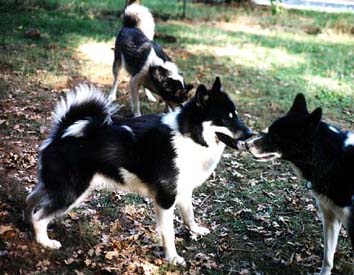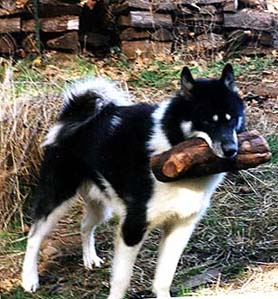Table of Contents
*
The Return
*
Dogs in Greenland
*
The Contribution of Dogs to Exploration in Antarctica
*
Page from the Behaviour Notebook: Raising Raven
*
Antarctic Sketches
*
Physiology of Sledge Dogs
*
The Qitdlarssuaq Chronicles, Part 2
*
News Briefs:
Thesis update
Blue Eye update
Mailbag
*
Product Review: DirectStop®
*
Book Review: Carved from the Land
*
Tip for the Trail: Re-lining Water Jug Caps
*
IMHO: Preservation vs. Saving
Navigating This
Site
Index of articles by subject
Index
of back issues by volume number
Search The
Fan Hitch
Articles
to download and print
Ordering
Ken MacRury's Thesis
Our
comprehensive list of resources
Talk
to The
Fan Hitch
The Fan
Hitch home page
ISDI
home page
Editor: Sue Hamilton
Webmaster: Mark Hamilton
Contents of The Fan Hitch Website and its publications are protected by international copyright laws. No photo, drawing or text may be reproduced in any form without written consent. Webmasters please note: written consent is necessary before linking this site to yours! Please forward requests to Sue Hamilton, 55 Town Line Rd., Harwinton, Connecticut 06791, USA or mail@thefanhitch.org

Raven (l) greets Bering
(r)
Senter
photo
Raising Raven
or
The Dog Fight Chronicles
by John Senter, Oregon, U.S.A.
Up until the beginning of September, 2001, we had four male Inuit Sled Dogs: Bering, age 6; Smokey, age 4; Shadow, age 3; and Storm, age 2. For security and to meet the expectations of the county, all are kenneled singly. They receive daily exercise periods in a half-acre fenced yard. My goal is to be able to let all the dogs out into the exercise yard at one time, allowing them to deal with any tensions that might exist among them and, ultimately, to be able to harness them all as one team without having a brawl break out. Fights occasionally happen, but not too often. Confrontations, usually bloodless, look and sound far worse than they actually are. These dogs had their hierarchy pretty well sorted out. All was well.
Then came Raven. He is a pure Inuit Sled Dog from Donald Mearns, of Pangnirtung, Nunavut on Canada's Baffin Island. Raven was one of six eight-week-old pups from one litter brought to the U.S. by Sylvia Feder in September, 2001. When it came my turn to pick from the litter, I asked for "the first male out of the gate when it's opened", on the theory that he will be a more energetic working dog. That was Raven! He was very assertive from the beginning.
Puppies being vulnerable, I have been very cautious when integrating a new one into the group. My mature dogs tend to be rather tough on each other as they sort out their pack hierarchy. I know this hierarchy is important, so I try to carefully ease a new youngster in with the adults, making the transition to the pack as safe and as enjoyable as I can. I use the 'uncle' method to do this. The first adult that a puppy meets is of a tolerant nature and not likely to cause injury. As the puppy becomes more self assured and a little bigger, I will then introduce him to the other dogs, one or two at a time. As each individual dog gets to know the pup, the pup, in turn, gets to know them and, more importantly, just what his limits are. Ideally, each new puppy will arrive here, be 'uncled', and will assume a properly subordinate position in the pack and mature according to nature's plan. But the world is not always ideal.
According to my plan, upon his arrival Raven met Bering and Taku. Taku was a big malamute, but by Raven's arrival, was twelve years old and pretty slow (he died November, 2002). Quite tolerant as long as the puppy behaved, he was still formidable when aroused. Shadow, as a puppy, was once bowled over just by Taku's bellowing. Bering is still very playful even though he's now middle-aged. He, too, is quite indulgent of puppies, but he will dominate one pretty much from the start. This is what I want.
Over the next few days, I introduced Raven to the other three dogs. There were no problems at first with Stormy or Shadow. Smokey, however, took an instant dislike to Raven and made him a special project from the beginning. However, Raven was not always the innocent victim of Smokey's predations.
From the getgo, I could see that Raven was nobody's wallflower and that there was a dynamic at work in my pack which I really hadn't seen before. Raven was always puppy-boisterous but with a certain sinister intent. I could see him sizing up the adult dogs to figure out who he had to bring down. Raven first formed an alliance with Stormy. The two are kenneled next to each other and are the only intact dogs here. Stormy was always pretty subordinate within the pack, so I thought he'd use this alliance to gain some status along with Raven.
On May 21, 2002, I noted there had been two major 'all hands' brawls in the previous two-week period. In both cases, Stormy and Raven ganged up first on Smokey, and later, Shadow. These were bloodless affairs, but from the sounds of it, not painless. Both Smokey and Shadow were put to ground and made to cry 'uncle.' In my dog diary, I wrote: "The last few days, Smokey has been a lot more polite to Raven, if not exactly deferential. I also notice that Raven is far more assertive around Shadow. Well, the kid is climbing the ladder whether or not I want him to, it seems. I guess he wants to be boss of all of them!"
By June, I decided I might be watching the ascent of a new boss dog. Raven was systematically deciding who he could bully and who he needed to bully. It is the way of Inuit Sled Dogs, I'm told, and so, barring major injuries to any of them, I resolved to let it unfold. Raven's alliance with Stormy served him well enough for a time. However he eventually decided that he didn't want to be equal to Stormy, but superior to him. Since then, he has generally bullied and threatened Stormy. I noted on June 23: "Yesterday, Smokey and Stormy were on the verge of fisticuffs but before it could get started, Raven interceded and prevented it. A real boss dog move. Later, a brief spat erupted, with Raven seemingly settling accounts with Stormy."

Raven and the 'Magic
Toy'
Senter
photo
One way Raven would try to get a rise out of the other dogs was the 'Magic Toy' game. The rules were simple. During exercise times, Raven would pick up a large piece of firewood lying somewhere in the exercise yard. He'd pack it around and make certain the other dogs knew it was his, and he'd fight to keep it, which, of course, was the whole point. Smokey was the only one who would ever challenge Raven for the toy. Smokey would wait until Raven put it down then move in to take it. Both dogs would silently hover over the toy, bristling, until one or the other of them would decide to quit. Seldom did it ever go to blows. When Smokey won, he'd carry it around just long enough to prove that he could take it from Raven any time he wished and there was nothing Raven could do about it. Once, after taking the stick, Smokey chewed it for a brief time then lost interest. Raven moved in at once, picked up the stick, played with it for a moment, then dropped it and urinated on it. They both made their point: Smokey was still boss and Raven was not boss yet, but still discernibly arrogant. In another instance, Stormy had the stick, Raven took it from Stormy and Smokey took it from Raven. Hierarchy at work!
Just when I thought I had a boss dog in the making, the paradigm shifted the other way. Raven had been having things his way, except that Smokey refused to be cowed by him. At some point, however, the others seem to have had about enough of Raven's guff also. On July 11th, there was an amusing incident with Raven entered Smokey's kennel run. Smokey took exception and blocked his exit for several minutes. After an intense threat display followed by a brief attack, Smokey finally let him out, but not until Raven's body language said that he'd had enough. I noted: "His tail was down, head turned to the aggressor, with a side-long look; lots of whites of the eyes showing. So, maybe I don't have a new boss dog yet, after all." And, in September, "…a pretty good little dust-up today. No bloodshed, and Raven, as usual, was in the middle of it. He had been acting pretty macho the whole time. Suddenly…it was Raven on the ground and it looked like every other dog was getting a piece of the action… Raven was scarcely humbled by the event, but I noticed later that he kept a close eye on Smokey and gave him a bit more space."
And so went the summer.
As of January 2003, the pack dynamics seem to have at last stabilized, at least to a degree. Raven, now nineteen months old, is still intact and bordering on physical maturity. All the dogs play and socialize daily in the exercise yard. Scuffles still happen at times, but there seems to be more mutual respect in the pack than before. The lines are drawn in the sand but are crossed only occasionally. Raven is not necessarily the boss dog, but neither is he at the bottom of the hierarchy. This was worked out by him and the other dogs. Interestingly, relations between Raven, Stormy and Smokey are also more cordial of late.
This past fall, Raven started working next to Bering, whose talents as Raven's uncle extend to the team as well. (All the younger dogs started out their careers next to Bering, who is a steady, reliable worker and very tolerant of puppy goof-ups in harness.) All indications are that Raven will be a superior working dog. Hopefully the noise, teeth, scuffles and bruised egos - the dogs' and mine - have prepared Raven to become a part of our team and to transition from puppy to working Inuit Sled Dog. I think the bottom line with Raven is this: He is a handful and always will be, certainly more than I first expected. But that's good. I have never had a dog quite like him. He has taught me a tremendous amount about dog handling and dog psychology that I would never have learned otherwise. I'm glad he's here.